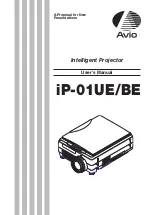
E-5
Safety Precautions
• Dew condensation
• Abruptly moving the unit to a place where there is a great temperature difference causes dew condensation on the main
unit.
Projection under a dew condensed state causes a failure.
• Servicing and cleaning
• Have the internal components cleaned by a retailer about once a year. There is a risk of fire or faulty operation if the
inside of the projector gets dusty and is not cleaned for a long time. For best results, the projector should be serviced
before the wet season brings damp conditions. Cleaning charges are at the discretion of the retailer.
• If not using the projector for a long period:
• If you do not plan to use the projector for a long time, disconnect the power cable for safety.
• Disposal
• Follow the recommendations of your local authority when disposing of the projector.
• Transporting the projector
• Use the special packaging when transporting the projector. The manufacturer cannot accept responsibility in the event of
damage or accident if other packaging is used.
• Use the special packaging no more than two times. Repeated usage reduces the shock absorbency of the packaging and
can lead to damage or accident.
• Transport the projector after the tilt stand is completely stored.
• Contact the retailer if you require new packaging.
• Lamp implosion
• A DC type Super High pressure lamp is used in this projector and it is rare for the lamp to explode during use. The unit is
also designed to forcibly turn off the lamp because there is a high possibility that the lamp will break if it is used beyond
the lamp usage of 2000 hours (Refer to pages E-46 and E-47).
Note the following things
• There will be a loud sound when a lamp explodes. The loud sound is due to the very high pressure inside the high-pres-
sure mercury lamp.
At this time, there is a risk that fine particles of glass and other material that result from the lamp explosion may be re-
leased to the outside from the ventilation slots.
During use, do not bring your face close to the vicinity of the ventilation slots (at the projector front, side, and rear).
• When a lamp explodes, the gas from within the lamp is released to the outside from the ventilation slots and resembles a
white smoke; however, this is not produced from heat generation or a fire. Note that mercury is contained in the gas inside
the lamp, and because of this, when a lamp has exploded, appropriate action should be taken including the opening of
windows and doors. Also, in the event that someone has inhaled the gas, please contact a doctor immediately.
Remedy
• A product containing a lamp that has exploded during use may have lamp fragments scattered within the product; there-
fore, without replacing the lamp please request repair service from the store of purchase, the dealer, or elsewhere.
Lamp replacement must not be undertaken by the customer when a lamp has exploded. Doing so will result in injury from
the lamp fragments, etc.
• Replacing the lamp
• Be sure to turn the lamp off and disconnect the power cable when the fan stops, and wait an hour or more before replac-
ing the lamp.
Replacing the lamp during operation or just after the power is turned off may cause burns due to heat.
Refer to “Replacement of the Lamp Unit” on page E-46 for the procedure.
• In regard to the disposal of the lamp unit, follow the disposal method of your municipality for the same type of waste as
common household fluorescent tubes.
• Cleaning the ventilation inlets and outlets
• To clean the ventilation inlets and outlets, unplug the power plug from the power outlet after the cooling fan stops.
Removal while the cooling fan is rotating may cause injury.
Please read “Cleaning the Air Intake/Ventilation Slots” on Page E-49 for information about the cleaning steps for the venti-
lation inlets and outlets.
• Avoiding malfunctions and accidents
• Adjust the Adjustable feet to keep the projector horizontally.
Using the projector in a tilted status may cause injury if it rolls over. Refer to
“Adjusting the Tilt” on page E-24 for the adjusting procedure.




















